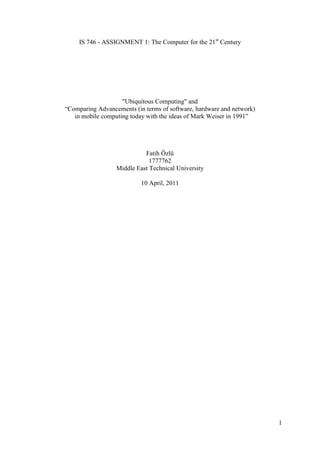The computer for the 21st century
- 1. IS 746 - ASSIGNMENT 1: The Computer for the 21st Century "Ubiquitous Computing" and ŌĆ£Comparing Advancements (in terms of software, hardware and network) in mobile computing today with the ideas of Mark Weiser in 1991ŌĆØ Fatih ├¢zl├╝ 1777762 Middle East Technical University 10 April, 2011 1
- 2. Ubiquity and MarkŌĆÖs Ideas Compared to Today As people are starting to use the most common technologies just about anywhere, at any time, as a result they become as a part of our everyday life, though mostly we are not aware of the fact that any technology is accessible to us at shop, at home, at work, or even from your car via mobile devices, pads, laptops or embedded systems. This phenomenon is named as ŌĆ£ubiquityŌĆØ, as Mark Weiser mentioned about that this kind of ubiquity calculation would become a part of environment in the forms of live boards, pads, tabs, etc in different sizes and with different abilities, in his article (Computer for the 21st Century, 1991). In addition, he gives example of engines that evolves and started to be used in many areas like for locking and unlocking doors, cleaning the windshield, and so on. So these technologies are very common and we are not aware of them where they are used until to think about them, in detail. The introduction sentence of the article reveals the main idea: ŌĆ£Specialized elements of hardware and software, connected by wires, radio waves and infrared, will be so ubiquitous that no one will notice their presence.ŌĆØ Mark supposes that ubiquities computers will be common to help people in all areas of the life in different sizes, each assigned to a particular task. As he describes, in the ŌĆ£embodied virtualityŌĆØ, tabs, pads and boards (yard size displays) participate at every part of the people life like wall notes, clocks, thermostats, or even a small piece of paper. The smallest ones are the tabs that will be used as pocket calculator or organizer that can make simple tasks of people by keeping tracks of people. These components could interact with other mobile computers, so they can exchange information, for example by shrinking a window onto the tab. The other ones, Pads about in the size of papers, will become alternative to the windows and will fulfill many more of paperŌĆÖs functions. Boards which have large displays will serve a lot with its screen for meetings, or other forms of collaborations for conference rooms and open areas. Compared to today, many similar devices are being used in our everyday lives as Mark has foreseen. IPods and IPhones or such mobile devices are very common, and people got accustomed to using them almost as the first necessity. In addition, examples of the boards can be seen at many areas for advertising of show cards, or scoreboards at stadiums, etc. So when thinking of these devices could interact between computers or other devices with many messaging protocols via Bluetooth or infrared, Mark is said to be good at foreseeing. 2
- 3. In the article, Mark adds that ŌĆ£Prototype tabs, pads and boards are just the beginning of ubiquitous computing.ŌĆØ and specifies that the real power of the concept comes from interaction of all of them. He takes attention to the fact that linking wired and wireless networks has some obstacles like common communication protocols or efficient data transmission rates. Although these issues are also important to be taken into consideration, the technology is as advanced as Mark foresighted. The mobile networks are now more interoperated and data transmission rate is fairly high, so as a result video telephone calls are even available by mobile phones. Another MarkŌĆÖs prediction is about ŌĆ£micro-kernelŌĆØ operating systems to perform specific functions can be added or removed without shutting down computers or mobile systems. He thinks future operating systems based on this principle can shrink quickly ŌĆ£to fit the changing needs of ubiquitous computationŌĆØ. Such an approach to this kind of problem is also important for todayŌĆÖs systems and most applications have tendency to have a base platform to be developed, though they have not need to be working mostly while adding a new functionality or removing. At now, most systems have these abilities. Last issue to be mentioned is about privacy, as considered in many information systems applications. Mark specifies that cryptographic techniques can be applied while sending messages one computer to another one to ensure private data is isolated from the public. Maybe, todayŌĆÖs the one of most important problems is privacy and to be ensured to safeguard private information. As Mark suggests his solution to this problem by cryptography, it is one of the choices can be applied to provide a total private information guard. As a result, by looking over the article itself, it is not possible to believe that it is an article with ideas from 1991. Each detail and issue has been nearly implemented or used in the real life, so it could be said that Mark had come up with exact practical ideas. 3
- 4. REFERENCES ’éĘ Mark Weiser, Palo Alto Research Center, Xerox, CA, USA, (September, 1991). The Computer for the 21st Century. 4




